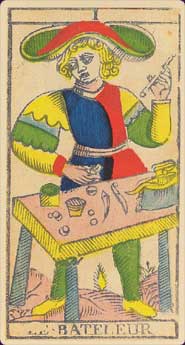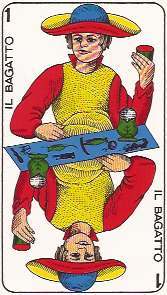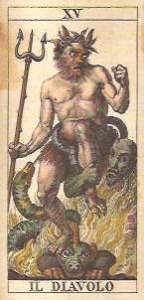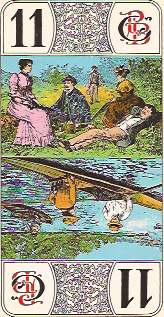
The first modern Tarot of Marseille that we know of was printed by Pierre Madenie of Dijon in 1709. This tarot was almost identical to its precursors, the Noblet and the Dodal. In 1736, Chosson de Marseille printed what would become the prototype of most later Marseille tarot cards. In the mid-1700s, tarots almost identical to those of Chosson were produced in France, Belgium and Switzerland. The version of Tarot de Chosson became the mother of all contemporary Marseille tarot cards in 1760 when Nicolas Conver from Marseille copied his tarot card directly onto wooden blocks. Conver’s Marseille tarot has become the standard Marseille tarot in France and is the model for most popular Marseille tarots used today.
Variants of the Tarot de Marseille

Although the Pope and Papesse cards were allegories that were respectful of the Church, Church officials of the 18th century considered them blasphemies and forced the card manufacturers in certain regions to replace these cards with other images. In the mid-1700s, the card maker Vandenborre from Brussels printed a typical Flemish-style game, but with the Spanish captain (or Captain Fracasse), an arrogant character from the Commedia Dell’Arte, replacing the Papesse. Bacchus riding on a barrel of wine took the place of the pope. Besançon tarot cards printed in Switzerland used Jupiter and Juno as replacement cards. The Bolognese tarot from Italy replaces the empress and the emperor as well as the Pope and the Pope with the four Moorish kings. The Church has clearly not seen the irony of seeing religious figures replaced by pagan figures.
The tarot of Marseille in Italy


In the 1700s, the Marseille tarot returned to the cradle of the Tarot, in northern Italy, where it evolved into the Lombard and Piedmontese styles. The first Italian tarot cards were identical to the Marseille tarot card, with misspelled French titles. Over time, they acquired Italian titles, became double headed and adopted unique design features.
Carlo Della Rocca from Milan designed a beautifully engraved tarot in 1835 known as Soprafino, which has become the quintessential Milan tarot. Some of his unique images include the devil sitting in the flames and surrounded by twisting green monsters; a red lobster on a silver platter on the Moon map; and a young couple dancing on the Sun card. The rigid cards of the Marseille tarot have acquired elaborate costumes, animated facial expressions and individual personalities. Point cards are decorated with graceful leaves, flowers and ribbons.
Tarock

By the late 1700s, card game players had gone to Tarock everywhere except Italy. Invented in Germany, Tarock quickly spread to Central Europe and Scandinavia and, in the 20th century, replaced Marseille tarot wherever tarot was still played. Tarock cards use French costumes (hearts, clubs, pikes and diamonds). The assets are double headed and have decorative images such as animals, rural scenes or ballerinas which have nothing to do with the traditional assets of the Tarot. While the Tarot de Marseille has remained static, the Tarock games, freed from the traditional imagery of the tarot, have become a vehicle for creative expression.
After the 1780s, play games and games of divination and esoteric studies separated. The traditional Marseille tarot with its medieval trumps and its costumes of swords, batons, cups and Italian coins, has gradually become an old-fashioned vestige clinging to life in some regions where gambling players are attached to their traditional tarot decks. The East of France was one of the last places to convert to the new Tarock games. This gave 18th century French occultists the opportunity to adopt the Marseille tarot as their own, preserving the traditional Marseille tarot deck from historical oblivion.
